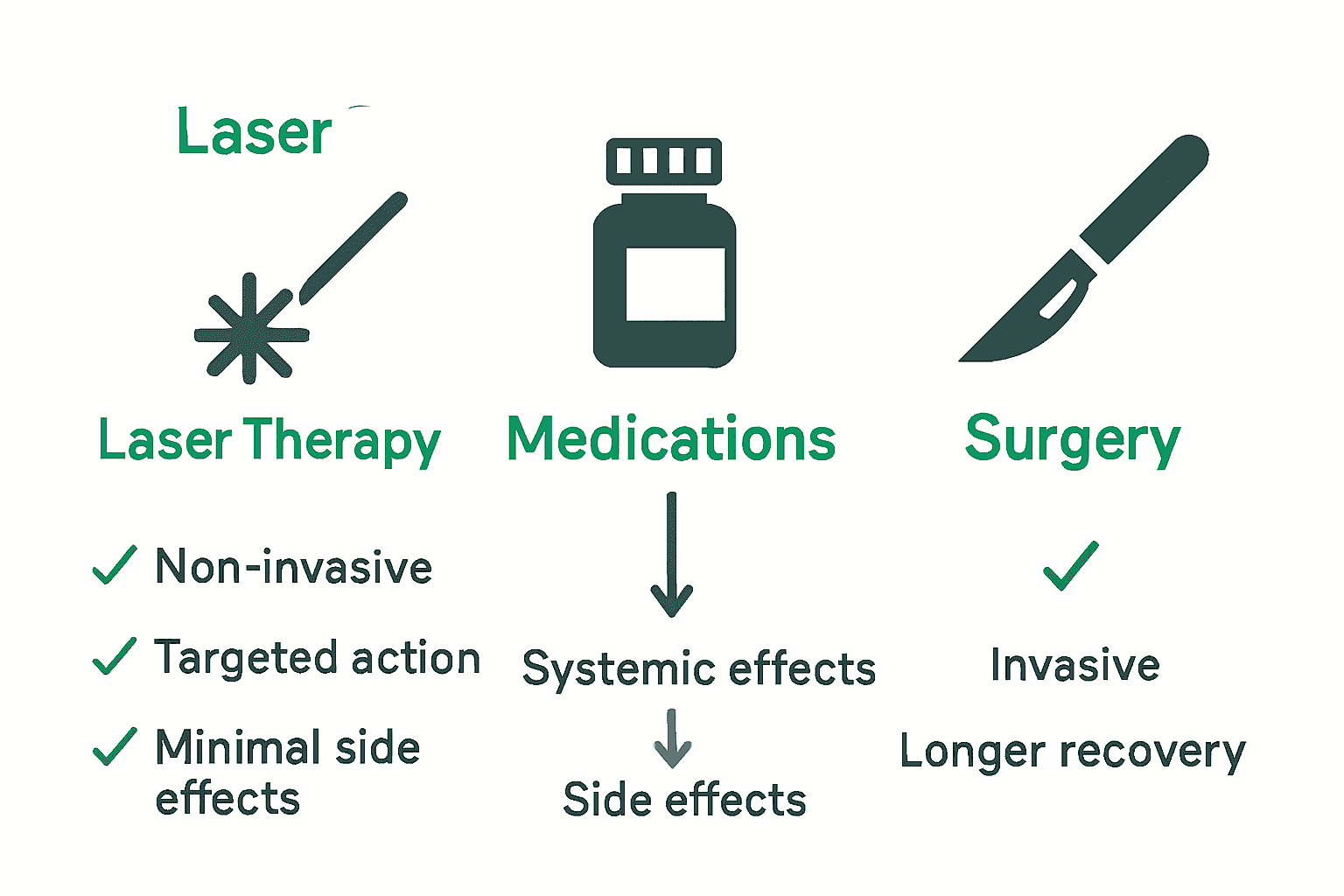More than 20 million people in North America deal with nerve pain every year, yet finding lasting relief often proves challenging. Chronic nerve discomfort can disrupt daily life and limit mobility, forcing many to search for alternatives to medication or surgery. Laser therapy has quickly become a popular choice because it offers targeted pain relief without invasive procedures and supports the body’s own healing process in a way that many other treatments cannot.
Table of Contents
- Defining Laser Therapy For Nerve Pain
- Types Of Laser Therapy Used In Pain Management
- How Laser Therapy Alleviates Nerve Pain
- Safety, Risks, And Contraindications Of Laser Therapy
- Comparing Laser Therapy To Other Pain Treatments
Key Takeaways
| Point | Details |
|---|---|
| Non-Invasive Pain Management | Laser therapy, particularly Low-Level Laser Therapy (LLLT), offers a safe and effective non-invasive option for treating nerve pain. |
| Mechanisms of Action | Laser therapy enhances cellular energy, reduces inflammation, and modulates pain signals, addressing both immediate and long-term pain. |
| Customization and Precision | Different laser therapy types, such as LLLT and High-Intensity Laser Therapy (HILT), allow personalized treatment plans targeting specific pain conditions. |
| Safety Considerations | Patient screening is crucial to identify contraindications, ensuring maximum safety during laser therapy application. |
Defining Laser Therapy for Nerve Pain
Laser therapy represents a groundbreaking, non-invasive approach to managing nerve pain by harnessing the power of focused light energy. According to research from PubMed, Low-Level Laser Therapy (LLLT), also known as photobiomodulation, involves applying low-intensity lasers directly to affected areas to stimulate cellular activity and promote healing.
This innovative treatment targets nerve pain at its source by penetrating deep into tissue layers, triggering natural biological responses that reduce inflammation and support cellular repair. By delivering specific wavelengths of light energy, laser therapy activates mitochondrial function, enhances blood circulation, and helps modulate pain signals transmitted through nerve pathways. The process is remarkably precise – allowing practitioners to address specific areas of nerve discomfort without invasive surgical interventions.
The core mechanisms of laser therapy for nerve pain involve several key biological processes:
- Cellular Regeneration: Stimulates mitochondrial energy production
- Inflammation Reduction: Decreases inflammatory markers in damaged tissues
- Pain Signal Modulation: Interrupts and reduces pain transmission pathways
- Enhanced Circulation: Improves blood flow to injured or painful nerve regions
Professional laser treatments for pain management offer a scientifically backed alternative for patients seeking relief from chronic nerve pain, providing a treatment option that supports the body’s natural healing mechanisms without relying solely on pharmaceutical interventions.
Types of Laser Therapy Used in Pain Management
Laser therapy encompasses several specialized techniques designed to address different types of nerve pain and tissue damage. Low-Level Laser Therapy (LLLT) represents the most common approach, utilizing low-intensity light waves to stimulate cellular healing and reduce inflammation. This technique is particularly effective for chronic pain conditions, targeting deep tissue regions without generating heat or causing tissue damage.
Another prominent laser therapy approach is High-Intensity Laser Therapy (HILT), which delivers more powerful light energy to penetrate deeper tissue layers. Unlike LLLT, HILT can generate slight thermal effects that enhance blood circulation and accelerate tissue repair. Practitioners often use this method for more severe pain conditions, including deep muscular injuries, significant nerve compression, and advanced inflammatory responses.
Three primary laser therapy classifications are used in pain management:
Here’s a summary of the main types of laser therapy used in pain management:
| Laser Type | Intensity Level | Key Benefits | Common Applications |
|---|---|---|---|
| Low-Level (LLLT) | Low | Reduces inflammation Stimulates healing |
Chronic pain Superficial nerve injuries |
| High-Intensity (HILT) | High | Enhances circulation Accelerates repair |
Deep tissue pain Severe nerve compression |
| Continuous Wave | Varies | Uniform tissue stimulation | General pain relief |
| Pulsed Wave | Varies | Reduces heat risk Protects tissue |
Sensitive or inflamed areas |
| Superpulsed | High-power, short duration | Deep penetration Intensive stimulation |
Advanced nerve pain Muscular injuries |
- Continuous Wave Lasers: Deliver consistent light energy for uniform tissue stimulation
- Pulsed Wave Lasers: Alternate between energy emission and brief pauses, reducing potential thermal stress
- Superpulsed Lasers: Generate extremely short, high-power light bursts that penetrate deeper tissue layers
For patients seeking comprehensive pain management solutions, how laser therapy helps treat inflammation provides additional insights into these advanced therapeutic techniques. Understanding these nuanced approaches allows healthcare professionals to customize treatments for individual patient needs, ensuring targeted and effective pain relief strategies.
How Laser Therapy Alleviates Nerve Pain
Laser therapy offers a sophisticated approach to managing nerve pain by targeting the underlying cellular mechanisms of discomfort and inflammation. According to PubMed research, Low-Level Laser Therapy (LLLT) is particularly effective, especially when using infrared lasers with power levels above 70mW, in alleviating neuropathic pain through precise cellular stimulation.
The therapeutic process works by penetrating deep into nerve tissue, triggering a cascade of healing responses. When laser energy interacts with cellular structures, it stimulates mitochondrial function, dramatically increasing adenosine triphosphate (ATP) production. This enhanced cellular energy accelerates tissue repair, reduces inflammation, and interrupts pain signal transmission. The result is a multi-layered approach to pain management that addresses both immediate discomfort and long-term healing mechanisms.
Key mechanisms of nerve pain alleviation through laser therapy include:
- Cellular Energy Boost: Stimulates mitochondrial ATP production
- Inflammation Reduction: Decreases pro-inflammatory cytokines
- Nerve Signal Modulation: Interrupts and rebalances pain transmission pathways
- Increased Circulation: Promotes blood flow to damaged nerve regions
- Tissue Regeneration: Supports natural healing of nerve and surrounding tissues
Patients struggling with chronic nerve pain can find comprehensive insights by exploring our top pain relief tips which complement laser therapy’s innovative approach to managing complex pain conditions. Understanding these intricate healing mechanisms empowers individuals to make informed decisions about their pain management strategies.
Safety, Risks, and Contraindications of Laser Therapy
Laser therapy is generally considered a safe and non-invasive treatment option, but like any medical intervention, it requires careful consideration of potential risks and individual patient circumstances. Patient screening plays a crucial role in determining the appropriate application of laser therapy, ensuring maximum safety and effectiveness for each unique case.
Certain medical conditions and situations require special precautions or may completely contraindicate laser therapy. Patients with the following conditions should exercise extreme caution or avoid the treatment entirely:
- Active Cancer: Potential risk of stimulating cancer cell proliferation
- Pregnancy: Particularly around the abdomen or lower back regions
- Photosensitivity Disorders: Increased risk of adverse skin reactions
- Active Infections: Potential for spreading or exacerbating existing infections
- Open Wounds or Recent Surgical Sites: Risk of improper healing
To mitigate potential risks, sciatica pain treatment professionals recommend a comprehensive pre-treatment assessment. This evaluation typically includes a detailed medical history review, current health status examination, and discussion of any potential contraindications. Practitioners use specialized protocols to modify treatment parameters, ensuring patient safety while maximizing therapeutic potential.
 Ultimately, the decision to proceed with laser therapy should involve a collaborative dialogue between the patient and their healthcare provider, carefully weighing individual health circumstances and potential benefits.
Ultimately, the decision to proceed with laser therapy should involve a collaborative dialogue between the patient and their healthcare provider, carefully weighing individual health circumstances and potential benefits.
Comparing Laser Therapy to Other Pain Treatments
According to PubMed research, Low-Level Laser Therapy (LLLT) emerges as a compelling alternative to traditional pain management approaches, offering a non-invasive solution with fewer systemic side effects compared to pharmaceutical interventions. The systematic review highlights LLLT’s potential as a viable treatment for neuropathic pain, emphasizing the importance of standardized application parameters to maximize therapeutic outcomes.
Unlike conventional pain treatments, laser therapy provides a unique approach to addressing chronic pain. Pharmaceutical treatments often rely on systemic medication that can produce widespread side effects, whereas laser therapy targets specific tissue regions with precision. Compared to surgical interventions, laser therapy is minimally invasive, requires no recovery time, and eliminates the risks associated with surgical procedures. Additionally, it stands in contrast to traditional physical therapies by delivering direct cellular stimulation that accelerates healing at the molecular level.

Key comparative advantages of laser therapy include:
- No Pharmaceutical Side Effects: Avoids systemic medication complications
- Non-Invasive Approach: Eliminates surgical risks and recovery periods
- Targeted Treatment: Focuses on specific pain sources
- Cellular-Level Healing: Stimulates natural repair mechanisms
- Minimal Discomfort: Provides pain relief without additional physical stress
Shockwave therapy offers another complementary approach for patients exploring alternative pain management strategies. While each treatment has unique benefits, laser therapy stands out for its precision, minimal invasiveness, and ability to support the body’s natural healing processes without introducing external chemicals or requiring extensive medical interventions.
Discover Personalized Laser Therapy Solutions for Lasting Nerve Pain Relief
If nerve pain has been holding you back, it is time to explore targeted, science-backed treatments that address pain at its cellular source. Laser therapy offers a gentle yet powerful approach to reducing inflammation, boosting tissue repair, and interrupting pain signals — all without invasive procedures or harsh medications. At Divergent Health, we specialize in advanced pain management solutions designed around your unique needs and goals.

Take the next step toward enduring relief by learning more about our innovative laser therapy services. Our experienced team combines cutting-edge technology with personalized care to improve your quality of life. Visit Divergent Health today and book your consultation to start your journey toward pain-free living.
Frequently Asked Questions
What is laser therapy for nerve pain?
Laser therapy for nerve pain is a non-invasive treatment that uses focused light energy to stimulate cellular activity, reduce inflammation, and promote healing in affected areas. It is especially effective for managing chronic nerve pain.
How does laser therapy alleviate nerve pain?
Laser therapy alleviates nerve pain by penetrating deep into nerve tissues, enhancing mitochondrial function, increasing ATP production, and improving blood circulation. This process helps reduce inflammation and modulate pain signals transmitted through nerve pathways.
Are there different types of laser therapy for pain management?
Yes, there are various types of laser therapy, including Low-Level Laser Therapy (LLLT), High-Intensity Laser Therapy (HILT), Continuous Wave, Pulsed Wave, and Superpulsed lasers. Each type has unique benefits and applications for different pain conditions.
What are the safety considerations for laser therapy?
While laser therapy is generally safe, certain conditions such as active cancer, pregnancy, photosensitivity disorders, active infections, and open wounds may warrant caution or contraindication. A thorough pre-treatment assessment is essential to ensure patient safety.
Recommended
- How Does Laser Therapy Help Treat Inflammation? – Pain and Injury Clinic in Calgary, AB – Divergent Health
- Laser Treatments for Pain near me – Divergent Health Calgary
- Shockwave Therapy: Complete Guide for Pain Relief – Pain and Injury Clinic in Calgary, AB – Divergent Health
- 7 Top Pain Relief Tips 2025 for Calgary Chronic Pain Patients – Pain and Injury Clinic in Calgary, AB – Divergent Health
- Explained: Trigger Point Therapies
- 7 Massage Techniques for Pain Relief You Should Try – Verdure Registered Massage Therapy

